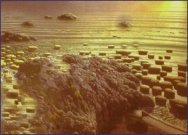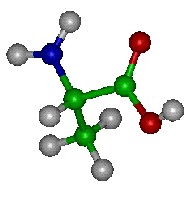Archaean
Time
the Archaen - 3.8 to 2.5 billion years ago
|
Also
see:
Tree of Life for Fossil Collectors |
|||||||||||
|
|
Earth
was a hostile place where only the raw ingredients of life existed.
After some 2 billion years, a crust had formed on the earth,
a rudimentary atmosphere existed, and water vapor had begun
to condense to form to beginnings of a marine environment essential
for life. The so-called primordial soup occurred from which
life begun was in all likelihood the sea, but there were no
eyewitnesses, and no laboratory can simulate the marine environmental
conditions that we can not even define. Until recently, we could
only reconstruct a history of life from the testimony of the
earth's most ancient rocks. Science almost always marks its
greatest progress at the conjunction of disciplines. The history
of The technology now exists to unravel ancient lineages through the sequencing of the genomes of extant species. The immutable law of natural selection dictates that life will retain those features that foster survival. These features, many most ancient relics, are still retained genes of every living organism. Grayness will always shroud our complete understanding of the origins of life, and we are satisfied with that mystery, as well as the resiliency and eternity of life. It could be said that organic chemistry (chemistry of carbon-based compounds) IS life. No matter whether the atoms of carbon, nitrogen, oxygen, and others were there at Earth's formation, or arrived later in bodies from space, they constituted the building blocks of life in a primordial soup. The very nature of carbon chemical bonding to itself and other atoms predetermines the formation of organic compounds, and the subsequent catalyzing of more complex organic compounds. And so it was on early-Earth, with all these organic compounds washed by rain into an increasingly rich marine environment. It is surprisingly easy for the chemical compounds believed present in the sea to have formed the classes of compounds found in all living cells, including amino acids, the basis for all proteins, sugars, and the chemical precursors of nucleotides that compose RNA and DNA.
|
|
|||||||||
|
|
|||||||||||
|
Fossil Mall Navigation: Navigate
by Fossil Category: l Fossils and Paleotological Science Information l |
||||||


 life,
we conjecture, will not be an exception. Together, geology and
paleontology, old sciences for sure, have found the eyewitnesses
so long missing. Our advanced civilization has now entered the
post-genomic era.
life,
we conjecture, will not be an exception. Together, geology and
paleontology, old sciences for sure, have found the eyewitnesses
so long missing. Our advanced civilization has now entered the
post-genomic era.  All
organisms, and all the cells that constitute them, are believed
to have descended from a common ancestor cell through evolution
by natural selection. Evolution is the central organizing principal
of biology, helping us make sense of the bewildering diversity
of life. Living cells probably arose on Earth some 3 ½
billion years ago through the spontaneous interaction of organic
molecules. It is likely that autocatalytic mechanisms inherent
to these organic systems began with the evolution of RNA molecules
that could catalize not only their own replication, but provided
a template for the production of additional protein catalysts.
As life and cells became increasingly complex over the eons,
a time was reached when the more chemically stable double helix
of DNA replaced the relatively unstable RNA to transmit a greater
amount of genetic information. RNA was relegated to a role of
performing two primeval functions, templates for protein production,
and catalysts for other RNA's. In this way, the appearance of
living organisms on Earth was preceded by a period of chemical
evolution, whereby the relative simple organic molecules gradually
begat more complex macro-molecules that could replicate themselves.
All
organisms, and all the cells that constitute them, are believed
to have descended from a common ancestor cell through evolution
by natural selection. Evolution is the central organizing principal
of biology, helping us make sense of the bewildering diversity
of life. Living cells probably arose on Earth some 3 ½
billion years ago through the spontaneous interaction of organic
molecules. It is likely that autocatalytic mechanisms inherent
to these organic systems began with the evolution of RNA molecules
that could catalize not only their own replication, but provided
a template for the production of additional protein catalysts.
As life and cells became increasingly complex over the eons,
a time was reached when the more chemically stable double helix
of DNA replaced the relatively unstable RNA to transmit a greater
amount of genetic information. RNA was relegated to a role of
performing two primeval functions, templates for protein production,
and catalysts for other RNA's. In this way, the appearance of
living organisms on Earth was preceded by a period of chemical
evolution, whereby the relative simple organic molecules gradually
begat more complex macro-molecules that could replicate themselves.